|
![[SOUNDSTAGE! LIVE]](../covers/ssmainlive.gif) The Best in Online Trade Show Reporting Show Report SummaryHI-FI '98 Report: The Equipmentby John Upton
Judging from the sheer number of tube-based products on active and passive display at HI-FI ‘98, the resurgence of interest in tube audio continues to be as strong as ever in 1998. I didn’t conduct an official survey, but I think it’s safe to say that at least half of the audio-only rooms at this year’s show featured at least one product making use of these glass-and-metal bottles of fire. With the exception of certain tube-equipped CD players and D/A converters, it is quite rare to find a tube audio product using just a single vacuum tube. When you consider the large number of tube-based products now available and use of multiple tubes in each product, the demand for high-quality audio tubes for use in this gear would certainly appear to be on the rise. As the supply of NOS tubes will not last forever, this demand will have to be met by modern manufacturers, several of whom were present at HI-FI ‘98. JJ Electronics, formed out of the privatization of the Tesla Factory in the Slovak Republic, was on hand with samples of their current-production tubes. Though their product line consists primarily of tubes traditionally found in power amplifiers (6L6GC, EL34, EL34L, EL84, KT88, 300B), JJ also produces a 12AX7A small signal tube. Each JJ tube is subjected to extensive inspection and testing by their distributor, Valve Amplification Company (VAC), and comes with a one-year warranty. Priced from $7.75 for a single 12AX7A to $282 for a matched pair of robust 300Bs, the JJ tubes would appear to offer an affordably priced, readily available alternative to some of the more expensive modern and NOS tubes. Also on hand was Westrex Corporation, which announced the expansion of their product line to include several exciting new tubes. Guitar players and push-pull tube-amp lovers will rejoice at the return of the MOV Gold Lion KT88 beam tetrode, which will be produced using the original manufacturing equipment in the UK. Also back into production is the massive 308B triode, which makes the Westrex 300B tube look like a sub-miniature in comparison. The 308B has a targeted consumer availability date of October 1998 and carries a hefty suggested retail of $1500 each. It was hard to envision an amplifier capable of housing these monstrous, 14" triodes, and when I mentioned this to a Westrex representative, I was directed to the room next door where Cary Audio’s Dr. Frankentriode, Dennis Had, was displaying his new Model CA1610 monoblocks. Had elected to go with a unique, double-decker amplifier design in the 1610 monoblocks, each of which featured a glowing 308B tube with the rest of the amp basically built around it. At a suggested retail of $37,500 per pair, the 1610 monoblocks pump out an impressive 65W per channel of class-A1 power and up to 100W in class A2. Oh, by the way, that’s 65W/100W single ended, which was plenty to drive a pair of Alón Circe speakers ($12,000) to ear-ringing levels without any audible strain. This was also one of the hottest rooms at the show, through it was difficult to say whether the considerable heat was generated by these massive amps or by the hordes of bodies packed sardine-style into this popular listening destination. If Cary’s 1610 amplifiers contained the tallest tubes at HI-FI ‘98, Moth Audio’s M 304TL monoblock amplifiers ($9600) featured the widest tube I’ve ever seen. Bearing a strong resemblance to an old-fashion street lamp, the 304TL output tubes generate 35W of single-ended class-A sound. The M 304TL amplifiers, fed a signal from a Pioneer transport and Moth Audio’s tube-powered HDCD U-DAC ($3500) through Moth’s PV4 passive volume control ($1485), powered a pair of Von Schweikert VR-6 loudspeakers to a wholly respectable listening level. Judging by the swarms of show attendees hovering about this room, it seems that moths aren’t the only creatures mesmerized by glowing glass bottles. What’s new?
Though NXT had constructed several "concept" speakers for active display at the show, it is not and will not be an actual manufacturer of retail products incorporating these panels. Instead, it is developing the technology for license to third-party manufacturers. To date, NXT has over 30 licensees including high-end stalwarts Martin-Logan, Audio Artistry, Rotel and TDL. Per NXT, consumer products featuring NXT panels may be ready for market by late 1999. Birdland Audio. While one ordinarily associates horn-loaded loudspeakers with micro-powered, single-ended tube amps, there is nothing preventing their use with solid-state designs as well. Newcomer Birdland Audio elected to go with the unconventional in their room, pairing the Avantgarde Acoustic’s Duo horn-loaded loudspeakers with their Pleyel 250 Reference amplifier ($3850). Named after Austrian composer Ignaz Pleyel, Birdland’s Pleyel Reference is a 50Wpc, solid-state design using a patent-pending open-loop output stage. I was surprised how good this horn/solid-state combination sounded, especially when fed a steady diet of 24-bit/96kHz recordings courtesy of a Theta transport and Birdland’s 24-bit Odéon-m1 DAC ($3500).
TacT Audio. While digital news at HI-FI ‘98 tended to center on the next standard in digital-disc technology, the technology incorporated in TacT’s Millenium ($9800) may well represent another, no-less-significant facet of the development of digital audio reproduction. Perhaps best described as "a D/A converter that happens to drive speakers," the new TacT Millennium "amplifier that is not an amplifier" uses a propriety PCM-to-PWM Equibit[TM] amplifier circuit to translate digital information into sound without the use of a conventional analog amplifier. My listening position during the active demonstration was considerably off-axis, but even from this less-than-desirable location, I was surprised by the ease and naturalness of the sound produced by the Millennium. Em-Phi. Em-Phi, a high-end manufacturer from France, debuted an impressive line of products including their Cyberlius AL70 tube amplifier ($5480), Cyberlius tube preamplifier ($4640), Arriane line of speaker cables and interconnects, and Harpus "acoustic panel" speakers ($10,400). The Em-Phi offering was one rare, exciting room that you walk into not knowing what to expect but have a hard time leaving once you’re there. I had never heard of any of this stuff before, but the depth, clarity, and tonal purity produced by this obviously well-thought-out combination of components left a positive impression on more than one SoundStage! reporter. A few "good sound, good price" rooms Manley Laboratories. The centerpiece of the Manley Labs room was the new, EveAnna Manley-designed Stingray integrated amplifier. Powered by an octet of "trusty" EL84 tubes, the Stingray combines two 50Wpc monoblocks and a passive preamplifier into a single, stingray-shaped chassis.
The sub-$2500 tube integrated market contains
some of the best value-per-dollar areas in all of high-end audio. At a suggested retail
price of just $2250, the Stingray would appear to be an instant and Music Hall. Known for its consistently excellent-sounding demonstration rooms, Music Hall did not disappoint at HI-FI ‘98. Featuring varying combinations of Creek solid-state electronics, EPOS speakers, and Cable Talk speaker cables and interconnects, Music Hall invariably captures the essence of the classic British hi-fi sound with affordably priced components. Of particular interest was the debut of the EPOS ES-15 ($1895), a ported, floorstanding version of the critically-lauded ES-12 bookshelf speaker.
AR (Acoustic Research). Subwoofers? Who needs ‘em. Certainly not the folks in the AR room, where their new P315 HO powered loudspeakers were doing their full range thing. Sporting a 1" dome tweeter, a pair of 5 1/4" midrange drivers, and a 15" side-firing low frequency driver, the P315s are said to be capable of reproducing sounds from 20Hz to 20kHz, +/- a few dBs. The 15" driver is self-powered by a 500W Sunfire amplifier actually built into the speaker, taking much of the burden off of the partnering amplification. As such, the P315s, with an 8-ohm nominal impedance, and 96dB sensitivity, would appear to be a suitable match for a vast number of amplifiers, both tube and solid state. Bottom line, those seeking a full-range, self-contained speaker without paying a considerable fortune would be well advised to audition the P315s, which offer a whole lot of performance for just $1995. Feeling horny? Few subjects in high-end audio provoke a more impassioned and divisive response as that of the horn-loaded loudspeakers. Hailed by some for their unique ability to project the output of certain gnat-powered tube amplifiers and condemned by others for much the same reason, fence sitters on the issue of whether or not a horn-loaded loudspeaker can be "high-end" are certainly an endangered breed. While horns have slowly been creeping in the back door of the house of high-end, a well-set-up horn system of high-end caliber is not exactly the most common of high-end experiences in a show environment. The HI-FI ‘98 show, for assorted factors, was perhaps not the ideal forum for horn-speaker crafters to display their wares, but there were a few active systems on display featuring horns, giving attendees a taste of what the whole tubes and horns thing is all about.
The latest incarnation of the Edgarhorn also made an appearance at HI-FI ‘98 in, of all places, the Monster Cable room, where it was powered by a pair of Mons Audio 300B monoblocks. Finally, Avantgarde Acoustic horn speakers from Germany were featured in the Audio Note and Birdland Audio rooms, though both environments seemed a mite restrictive for these sizable transducers. "Step above" sound Monitor Audio. Monitor Audio, the company with the metal-cone drivers, was back with two complete systems at two very different price points. The top-of-the line system was built around Monitor’s top-of-the-line Studio 60 speakers ($10,000-$12,000 depending on finish). I was quite favorably impressed with these slender, three-way floorstanders at HI-FI ‘97 and the active display at HI-FI ‘98 did nothing but reinforce this opinion. The quantity and quality of bass performance Monitor manages to coax out of a pair of 6" woofers is quite astonishing. Of course, the accompanying electronics, which included a pair of Krell FPB-200 monoblocks, Audio+Video Standard preamp/processor, and KAV-300 CD player certainly did not diminish the sonic capabilities of the excellent, albeit pricey, two-channel system. Also on active display was one of Monitor’s more accessibly priced speakers, their two-way model 700 PMC ($1000). These biwireable, two-way bookshelf speakers sport a 6" PMC gold-alloy woofer along with a gold-dome tweeter. While obviously unable to match the sweeping sonic performance of its much bigger brother, the Studio 60, the 700 PMC’s sonic resemblance was clearly evident. Partnered with the more modestly priced electronic components (Krell KAV 250 CD, Krell KRC-3 preamp, SimAudio Celeste W-3 power amp], the 700 PMC sounded more than capable of holding its own against any bookshelf speakers anywhere near its price. GNP Audio Video. GNP Audio Video, a Pasadena, California-based high-end audio and video dealer, put together one of the overall finest-sounding rooms of the show. The system consisted of Thiel 2.3 floorstanding loudspeakers ($3200 to $3300 depending on finish) and an assortment of Audio Research electronics including LS25 vacuum-tube preamplifier, VT 100 MKII power amplifier, and CD2 CD player. What really set this particular room apart from all too many others at the show was the seamless integration of these products into the listening environment available. Undoubtedly due, at least in part, to the skillful and liberal use of ASC treatment products, the GNP exhibit was one of the few at the show where the system didn’t seem to be at war with the room. Thiel speakers had always left me a bit cold at previous shows, but I’m beginning to think this was the fault of the setup, not necessarily the speakers.
Bow Technologies. While most exhibitors at
HI-FI ‘98 strove to create a neat, well-ordered listening environment, the folks at
Bow Technologies went to the opposite extreme by electing the "Construction Because of the vast number of variables affecting a show-environment listening room, drawing any meaningful conclusions on the sonic merits of a particular piece of equipment at a show can be hazardous at best. Certain products, however, just seem to stand out as offering truly exceptional performance. One such product is the Bow Technology ZZ-Eight HDCD compact disc player ($6900), which does everything as good or better than any single- or multi-box digital playback system I’ve heard at any show. Also featured in this room was Bow’s stylish Wazoo integrated ($2800), a zero-negative-feedback, solid-state design. Vandersteen. After spending a couple of days at the show, my tolerance for problematic speaker/room interactions became markedly reduced. Room treatment, where intelligently applied, was able to alleviate certain problems, and, as a general rule, heavily treated rooms tended to sound better than lightly treated or untreated rooms. One of the notable exceptions to this trend was the Vandersteen/Audio Research room, which contained no visible treatment devises of any sort. The Vandersteen Model 5s ($9800) are big speakers, the kind of speakers that one would ordinarily expect to distress a smaller-sized listening environment. I trudged in fully expecting to be boomed and echoed right out of there, but contrary to my pre-conceived expectations, the Vandersteen/Acoustic Research system sounded just about as right as any system at the show. I thought this might be due, at least in part, to this whole time-and-phase-alignment thing SoundStage!’s Doug Blackburn is always talking about. Perhaps it is, but I also learned that the Model 5s, with their tunable, self-powered woofers and dealer-adjustable compensation controls, can be contoured to suit almost any listening environment -- a definite advantage in show-type environments. |
|
Copyright © 1998 |
|
![[SOUNDSTAGE]](pics/toplefttop.gif)

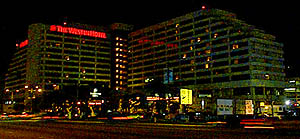 Tubes, tubes, and more
tubes
Tubes, tubes, and more
tubes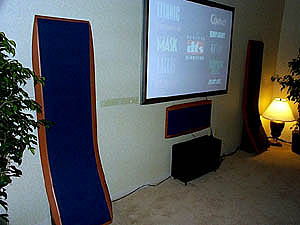 NXT. During a June 10 press
conference in the Westin’s Grand Trattoria conference room, New Transducers, LTD.
(NXT) updated the development status of their all-new flat-panel loudspeaker technology.
Relying on complex panel vibrations to generate sound waves (as opposed to the
back-and-forth motions of conventional drivers), NXT contends that the sound radiated by
these panels is completely diffuse, offering superior integration into most listening
environments. Other claimed benefits of the visually unobtrusive NXT-designed panels
included exceptional off-axis response and a high degree of linearity.
NXT. During a June 10 press
conference in the Westin’s Grand Trattoria conference room, New Transducers, LTD.
(NXT) updated the development status of their all-new flat-panel loudspeaker technology.
Relying on complex panel vibrations to generate sound waves (as opposed to the
back-and-forth motions of conventional drivers), NXT contends that the sound radiated by
these panels is completely diffuse, offering superior integration into most listening
environments. Other claimed benefits of the visually unobtrusive NXT-designed panels
included exceptional off-axis response and a high degree of linearity.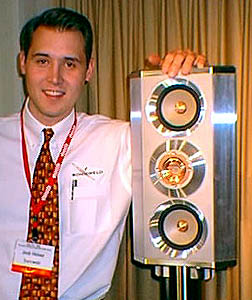 Sonicweld. Giving new
meaning to the words "heavy metal," Sonicweld debuted their Timpanogos model
loudspeaker ($29,600), a 160-pound stand-mounted speaker machined from "solid billets
of aerospace alloys." The price includes a pair of dipolar subwoofers, used in
prototype form at the show, which feature entirely machined construction and built-in
800Wpc amplification. Sonicweld's Josh Heiner also claims to have developed a crossover
for this speaker that uses no reactive parts (capacitors, inductors) in the signal path.
Details on how this feat of engineering was accomplished were not forthcoming,
unfortunately.
Sonicweld. Giving new
meaning to the words "heavy metal," Sonicweld debuted their Timpanogos model
loudspeaker ($29,600), a 160-pound stand-mounted speaker machined from "solid billets
of aerospace alloys." The price includes a pair of dipolar subwoofers, used in
prototype form at the show, which feature entirely machined construction and built-in
800Wpc amplification. Sonicweld's Josh Heiner also claims to have developed a crossover
for this speaker that uses no reactive parts (capacitors, inductors) in the signal path.
Details on how this feat of engineering was accomplished were not forthcoming,
unfortunately.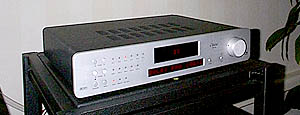 While its price
may border on entry level (well, maybe entry-levelish), the sonic performance of
this unit did not seem meaningfully compromised. Sandwiched between a top-notch front-end
(Classe transport - right, Manley Reference DAC) and a pair of excellent speakers (Tannoy
Churchills), the Stingray did not sound mismatched or in any way out of place.
While its price
may border on entry level (well, maybe entry-levelish), the sonic performance of
this unit did not seem meaningfully compromised. Sandwiched between a top-notch front-end
(Classe transport - right, Manley Reference DAC) and a pair of excellent speakers (Tannoy
Churchills), the Stingray did not sound mismatched or in any way out of place. 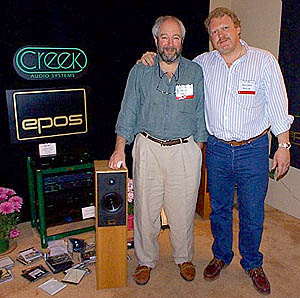 worthy contender at this price point.
worthy contender at this price point. 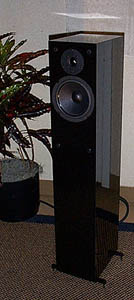 NHT. Do we detect a trend
developing? Like EPOS, NHT has elected to incorporate a highly successful bookshelf
platform into a more full-range, floorstanding speaker. NHT placed the essence of their
Super One loudspeaker system into a 39" speaker cabinet and, for good measure, adding
a down-firing 6.5" subwoofer. The end result is the NHT SuperTwo, a speaker boasting
of a frequency response of 35Hz-25KHz, an 8 ohm nominal impedance, and 87dB sensitivity.
Powered by a full compliment of electronics from Audiolab’s 8000 series, the sound
pumping out of the SuperTwos had a depth and quality that belied their modest $750
suggested retail price.
NHT. Do we detect a trend
developing? Like EPOS, NHT has elected to incorporate a highly successful bookshelf
platform into a more full-range, floorstanding speaker. NHT placed the essence of their
Super One loudspeaker system into a 39" speaker cabinet and, for good measure, adding
a down-firing 6.5" subwoofer. The end result is the NHT SuperTwo, a speaker boasting
of a frequency response of 35Hz-25KHz, an 8 ohm nominal impedance, and 87dB sensitivity.
Powered by a full compliment of electronics from Audiolab’s 8000 series, the sound
pumping out of the SuperTwos had a depth and quality that belied their modest $750
suggested retail price. 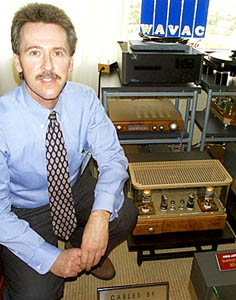 TMH Audio, the US importer
and distributor of Köchel speakers from Korea and WAVAC Electronics from
Japan, displayed an active system build around the Kochel horn loudspeaker ($8995-$9995
depending on finish). A three-way design featuring a 12" back-loaded horn, a 2"
compression driver CD horn for the midrange and a 1.75" compression driver
140-degree-dispersion slot horn, the Köchel speaker boasts of 97dB sensitivity within
8ohm nominal impedance. While these specs would make it a suitable partner for a tiny 2A3
or 300B single-ended tube amplifier, at the show they were provided considerably more
power courtesy of some breathtakingly expensive and impeccably well-build WAVAC tube
electronics. Horns are typically panned for imparting a "cupped hands"
coloration to the source materials, but I noticed very little of this phenomenon through
the fine-sounding Köchels.
TMH Audio, the US importer
and distributor of Köchel speakers from Korea and WAVAC Electronics from
Japan, displayed an active system build around the Kochel horn loudspeaker ($8995-$9995
depending on finish). A three-way design featuring a 12" back-loaded horn, a 2"
compression driver CD horn for the midrange and a 1.75" compression driver
140-degree-dispersion slot horn, the Köchel speaker boasts of 97dB sensitivity within
8ohm nominal impedance. While these specs would make it a suitable partner for a tiny 2A3
or 300B single-ended tube amplifier, at the show they were provided considerably more
power courtesy of some breathtakingly expensive and impeccably well-build WAVAC tube
electronics. Horns are typically panned for imparting a "cupped hands"
coloration to the source materials, but I noticed very little of this phenomenon through
the fine-sounding Köchels.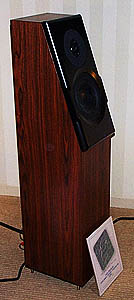 Meadowlark.
Show in and show out, there are certain exhibitors who know how to set up and run
their rooms to achieve the best sonic results. Meadowlark’s Srajan Ebaen is
definitely one of the better ones. I was simply blown away by the sound he was able to
coax out of the comparatively inexpensive, transmission-line Shearwater speakers ($2000 to
$2500 with "Hot Rod" parts upgrade - shown right). I’d heard the
Shearwaters in the past with tube electronics, but here, they were powered by an excellent
solid-state system consisting of Naim’s CD-X compact disc player ($4250), NAC 102
preamp ($2250), flatcap power supply upgrade ($750), and NAP 250 power amp ($3550). The
Shearwaters seem to be equally at home coupled with tube or transistor amplifiers, and I
suspect that a hybrid amp wouldn’t sound too bad with them either.
Meadowlark.
Show in and show out, there are certain exhibitors who know how to set up and run
their rooms to achieve the best sonic results. Meadowlark’s Srajan Ebaen is
definitely one of the better ones. I was simply blown away by the sound he was able to
coax out of the comparatively inexpensive, transmission-line Shearwater speakers ($2000 to
$2500 with "Hot Rod" parts upgrade - shown right). I’d heard the
Shearwaters in the past with tube electronics, but here, they were powered by an excellent
solid-state system consisting of Naim’s CD-X compact disc player ($4250), NAC 102
preamp ($2250), flatcap power supply upgrade ($750), and NAP 250 power amp ($3550). The
Shearwaters seem to be equally at home coupled with tube or transistor amplifiers, and I
suspect that a hybrid amp wouldn’t sound too bad with them either.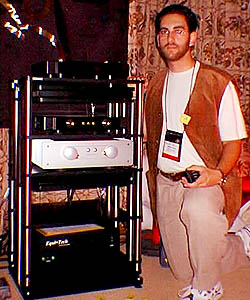 Zone Chic" look, complete with pylons and road signs. While the decor
was perhaps appropriate for the work-in-progress Blue Trumpet Research speakers form
Denmark, the Bow Technologies electronics powering the system were very much finished
products.
Zone Chic" look, complete with pylons and road signs. While the decor
was perhaps appropriate for the work-in-progress Blue Trumpet Research speakers form
Denmark, the Bow Technologies electronics powering the system were very much finished
products.